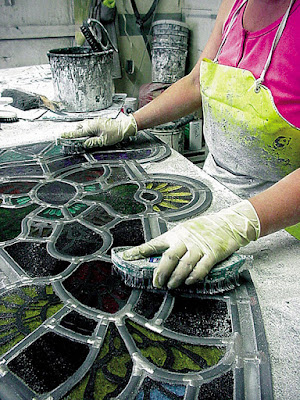There are several ways to darken the leads in leaded
panels. Three are to:
use patina on the leads,
brush with on stove blackening
with a soft brush, and
simply brush after cementing.
A certain number of people use black patina to darken the
leads after cementing and cleaning the panel.
This certainly gives a black result, but it introduces an acid to the
panel. I do not do this, nor do I recommend it.
Another method of darkening is to apply stove blackening
or black oil paint to the panel to make the leads dark. I recommend that you put very small amounts
on a soft brush and then brush over the leads.
It might have to have a little more colour added for a large panel, but
that is better to add more than to clean up large areas of smudged black over the
glass, especially with painted glass.
But...
You can darken lead came without patina or black
colour. You finish the panel with the
scrubbing brush to push whiting against the fillet of lead light cement against
the leads as normal. This has the effect
of cleaning the glass as well as stiffening the cement at the edge of the
cames. Remove the excess whiting as normal.
But, before picking out all the excess cement once the
scrubbing brush process is finished, use a soft brush, such as a shoe brush, over
the whole panel. This can be mechanised
by using a soft bristled mop in a drill motor on a slow to medium speed. This will pick up colour from the cement and
spread it evenly over the lead and solder joints. It will give a dark grey
appearance to the whole of the leading and solder joints as well as polish up the glass.
The degree of shine will be dependent on the amount of
time you wish to spend, but can be a polished to a very dark grey to black
colour. This will last longer than
simple black colour brushed onto the leads, as it is bound by the linseed oil
in the cement to the surface of the leads. Also, it quickly dries so that not
so much black is transferred to your hands as you handle it.
Making lead cames black during the finishing of a leaded
panel is as simple as brushing over the cames before picking out all the excess
lead light cement.








